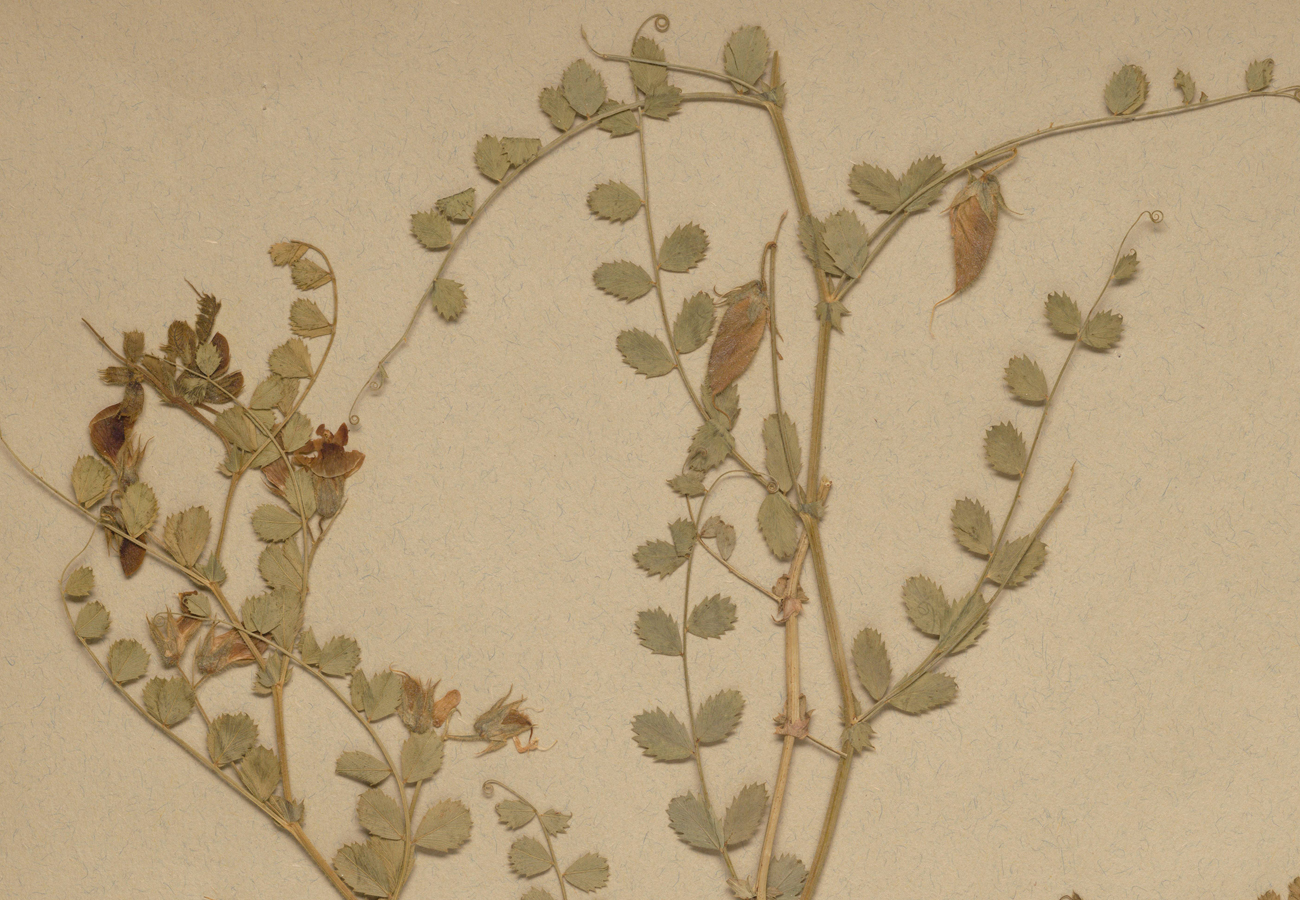Abstract
Cicer Linnaeus (1753: 738), as currently established, includes about 50 species distributed from north to south from the Altai Mountains (C Asia) to the East African Rift (E Africa), and from west to east from the Canary Islands (W Africa) to the upper Irtysh River in Dzungaria (C Asia) (van der Maesen et al. 2007, Dönmez 2011, Toker et al. 2021). In the course of our revisionary work on this genus for Caucasian flora conspectus (Takhtajan 2003), we found the name C. anatolicum Alefeld (1861: 349) and its synonym C. glutinosum Alefeld (1861: 349), also the name C. minutum Boiss. & Hohen. in Boissier (1849: 130) that warrant lectotypification in accordance with the Shenzhen Code (Turland et al. 2018). The second-step lectotypification is made for C. anatolicum and C. minutum, while the lectotype is selected for C. glutinosum based on the analysis of their protologues and original herbarium material deposited in C, BM, G, LE, M, MO, P and WAG. Herbarium acronyms mentioned here follow Thiers (2021-onward).
References
<p>Alefeld [F.G.C.] (1861) Ueber Cicer soongoricum Stephan. Bonplandia 9: 348–349.<br>Al-Shehbaz, I.A. & Barriera, G. (2019) Typification of Edmond Boissier’s Cruciferae (Brassicaceae) names enumerated in Flora Orientalis. Boissiera 72: 1–192.<br>Ascherson, P. & Graebner, P. (1909) Synopsis der mitteleuropaïschen flora 6 (2). W. Engelmann, Leipzig, 1093 pp. https://doi.org/10.5962/bhl.title.35810<br>Bernard, P. (1997) Le voyage dans l’Empire othoman, l’Égypte et la Perse de Guillaume-Antoine Olivier, naturaliste et envoyé de la République (1792–1798). Comptes rendus des séances de l’Académie des Inscriptions et Belles Lettres 141: 1157–1244. https://doi.org/10.3406/crai.1997.15811<br>Boissier, E. (1849) Diagnoses plantarum orientalium novarum. ser. 1, 9. Typis Marci Ducloux et Cons, Parisiis [Paris], 131 pp.<br>Boissier, E. (1872) Flora Orientalis: sive, Enumeratio plantarum in Oriente a Graecia et Aegypto ad Indiae fines hucusque observatarum 2. H.Georg, Genève, Basel & Lyon, 1159 pp. https://doi.org/10.5962/bhl.title.20323<br>Bornmüller, J. (1941) Bemerkenswerte floristische Funde im Ala Dag II. Repertorium specierum novarum regni vegetabilis 50: 133–150.<br>Charpin, A. (2011) Les voyages d’Emond Boissier: en Grèce et au Moyen-Orient. Archives des sciences 64: 25–42. http://doi.org/10.5169/seals-738418<br>Davis, P.H. (1970) Cicer L. In: Davis, P.H. (Ed.) Flora of Turkey and the East Aegean Islands 3. Edinburgh University Press, Edinburgh, 267–274.<br>Dönmez, A.A. (2011) Cicer uludereensis Dönmez: a new species of Cicer (Chickpea) (Fabaceae) from around the Fertile Crescent, SE Turkey. Turkish Journal of Botany 35: 71–76. https://doi.org/10.3906/bot-1001-283<br>Edmondson, J.R. & Lack, H.W. (2006) Karl Georg Theodor Kotschy’s itinerary in southern Iran, 1841–42. Willdenowia 36: 579–588. https://doi.org/10.3372/wi.36.36154<br>Hiepko, P. (1987) The collections of the Botanical Museum Berlin-Dahlem (B) and their history. Englera 7: 219–249. https://doi.org/10.2307/3776724<br>Jacquemoud, F. (2011) Sur l’herbier d’Edmond Boissier et la création d’un Herbier du Flora Orientalis (G-BOIS): conservation, exploitation et actualité d’un patrimoine scientifique et culturel de valeur universelle. Archives des sciences 64: 57–76. http://doi.org/10.5169/seals-738420<br>Kotschy, T. (1861) Der westliche Elbrus bei Teheran. Mittheilungen der Kaiserlich-Königlichen Geographischen Gesellschaft in Wien 5: 65–110.<br>Lack, H.W. (2020) Theodor Kotschy in Iran, 1841–1843. Botanical collections and an early printed vegetation profile. Candollea 75: 31–43. https://doi.org/10.15553/c2020v751a3<br>Linczevski, I.A. (1948) Cicer L. In: Komarov, V.L. (Ed.) Flora SSSR [Flora of the USSR] 13. Izdatel’stvo Akademii nauk SSSR, Moscow & Leningrad, pp. 386–406. [in Russian]<br>Linnaeus, C. (1753) Species plantarum. Impensis Laurentii Salvii, Holmiae [Stockholm], 1200 pp. https://doi.org/10.5962/bhl.title.669<br>McNeill, J. (2014) Holotype specimens and type citations: General issues. Taxon 63: 1112–1113. https://doi.org/10.12705/635.7<br>Olivier, G.A. (1807) Voyage dans l’empire Othoman, l’Égypte et la Perse, fait par ordre du gouvernement, pendant les six premières années de la république 5. Сhez H. Agasse, Paris. 485 pp.<br>Pallas, P.S. (1797) Plantae novae ex herbario et schedis defuncti Botanici Iohannis Sievers. Nova Acta Academiae Scientiarum Imperialis Petropolitanae. Praecedit Historia ejusdem Academiae 10: 369–383.<br>Ponert, J. (1973) Neue taxonomische Kombinationen, Kategorien und Taxa vor allem der Türkischen Arten. Feddes Repertorium 83: 617–644. https://doi.org/10.1002/fedr.19730830902<br>Stafleu, F.A. & Cowan, R.S. (1976) Taxonomic literature: a selective guide to botanical publications and collections with dates, commentaries and types (Ed. 2) 1. Bohn, Scheltema & Holkema, Utrecht, 1136 pp. https://doi.org/10.5962/bhl.title.48631<br>Stafleu, F.A. & Cowan, R.S. (1981) Taxonomic literature: a selective guide to botanical publications and collections with dates, commentaries and types (Ed. 2) 3. Bohn, Scheltema & Holkema, Utrecht, 980 pp. https://doi.org/10.5962/bhl.title.48631<br>Takhtajan, A.L. (Ed.) (2003) Caucasian flora conspectus 1. St. Petersburg University Press, St. Petersburg, 204 pp. [in Russian]<br>Thiers, B. (2021 [continuously updated]) Index Herbariorum. A global directory of public herbaria and associated staff. New York Botanical Garden’s Virtual Herbarium. Available from: http://sweetgum.nybg.org/science/ih (accessed 11 January 2021)<br>Toker, C., Berger, J., Eker, T., Sari, D., Sari, H., Gokturk, R.S., Kahraman, A., Aydin, B., von Wettberg, E.J. (2021) Cicer turcicum: a new Cicer species and its potential to improve chickpea. Frontiers in Plant Science 12: 1–17. https://doi.org/10.3389/fpls.2021.662891<br>Turland, N. (2019) The Code Decoded. A user’s guide to the International Code of Nomenclature for algae, fungi, and plants (Ed. 2). Sofia, Pensoft Publishers, 196 pp. https://doi.org/10.3897/ab.e38075<br>Turland, N.J., Wiersema, J.H., Barrie, F.R., Greuter, W., Hawksworth, D.L., Herendeen, P.S., Knapp, S., Kusber, W.-H., Li, D.-Z., Marhold, K., May, T.W., McNeill, J., Monro, A.M., Prado, J., Price, M.J. & Smith, G.F. (Eds.) (2018) International Code of Nomenclature for algae, fungi, and plants (Shenzhen Code) adopted by the Nineteenth International Botanical Congress Shenzhen, China, July 2017. [Regnum Vegetabile 159]. Koeltz Botanical Books, Glashütten, 254 pp. https://doi.org/10.12705/Code.2018<br>van der Maesen, L.J.G. (1972) Cicer L., a monograph of the genus, with special reference to the chickpea (Cicer arietinum L.), its ecology and cultivation. Mededelingen van de Landbouwhogeschool Wageningen 72–10. pp. 1–342.<br>van der Maesen, L.J.G. (1979) Cicer. In: Rechinger, K.H. (Ed.) Flora Iranica: Flora des iranischen Hochlandes und der umrahmenden Gebirge, Persien, Afghanistan, Teile von West-Pakistan, Nord-Iraq, Azerbaidjan, Turkmenistan 140. Akademische Druck- und Verlagsanstalt, Graz, 1–15.<br>van der Maesen, L.J.G. (1987) Origin, history and taxonomy of Chickpea. In: Saxena, M.C. & Singh, K.B. (Eds.) The chickpea. C.A.B. International, Wallingford, pp. 11–34.<br>van der Maesen, L.J.G., Maxted, N., Javadi, F., Coles, S. & Davies, A.M.R. (2007) Taxonomy of the genus Cicer revisited. In: Yadav, S.S., Redden, R.J., Chen, W. & Sharma, B. (Eds.) Chickpea breeding and management. CABI Publishing, Wallingford, pp. 14–46. https://doi.org/10.1079/9781845932138.002</p>


